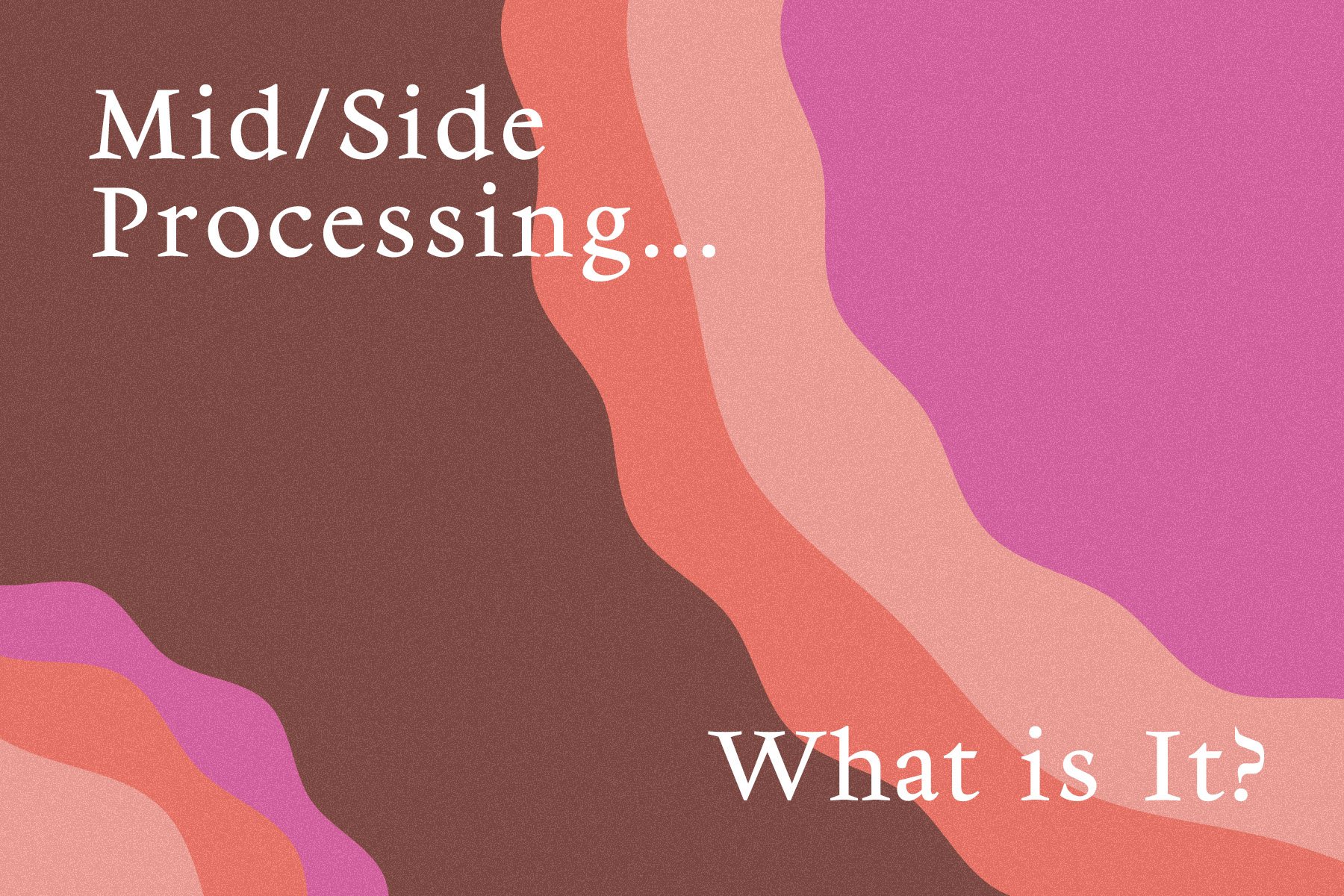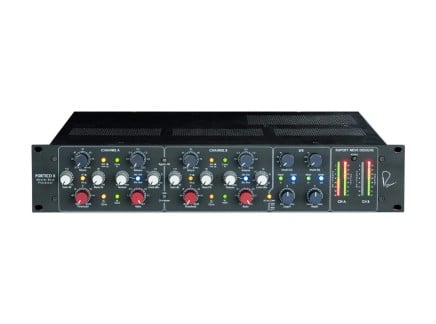Mid-side (M/S) processing is a unique way of processing stereo audio, ultimately allowing you to manipulate the mid and side information separately. It functions differently than traditional stereo processing, and in some cases can allow for more tailored control over individual mix elements.
This type of processing can be useful for fixing issues with stereo image, tonal balance, and clarity—but it’s not just about fixing things. You can get really creative with it, especially for genres like electronic music where there aren’t as many mixing “rules” as more traditional musical styles.
In this article we’ll go over what M/S processing is, how it works, some basic techniques, benefits, and uses for it.
What is Mid-Side Processing and How Does it Work?
Mid-side processing splits a stereo signal into two parts—the middle (M) and left and right sides (S). Through encoding it lets you process the central, mono-compatible information independently from the stereo information.
Mid-side processors work by reinterpreting a stereo signal as mid and side channels. The mid channel is comprised of the material that is common between the left and right channels in the original stereo signal, and the side channels represent the differential between the original left and right channels. On the output it goes through decoding, a reverse process of the encoding algorithm. The processor takes the separated channels and rebuilds them into a standard stereo signal.
So, let's talk about why this matters by examining the mid and side signals individually.
Middle
The middle element is representative of what’s panned center in the original stereo signal. Think about signal sources that are generally kept in center panning position. Lead vocals, bass guitar, snare drum, and kick drum are just a few relatively common examples.
What they have in common is that they are the bedrock of a typical mix. A cohesive middle channel is also a critical part of mono compatibility for accurate playback translation across different devices.
Sides
The side(s) channel represents the differences between left and right signal information. They provide a track a sense of width and space. Using clever EQ moves or stereo imaging plugins like the Waves S1 can enhance the sonic stage, and multi-band compression lets you better dictate which mix elements are more up front.
How Mid-Side Processing Enhances the Mix
As more and more plugins offer M/S features, how engineers approach using it has changed. For a while, it was mostly relegated to the mastering phase for the critical final touches on a mix—but as plugins have gotten more sophisticated mid-side processing has become a go-to technique during the mixing stage, as well. Let's discuss some of the ways it can be used to enhance a mix.
More Detailed EQ Balance
Sometimes you need to make EQ moves that a standard equalizer just can’t do. If you’re noticing one side of the mix has more of a certain frequency area like the low midrange, this can lead to the other side sounding too bright, or “leaning”. With M/S processing you can EQ the sides without affecting the middle to balance things out.
Clarity and Focus
For the most part, separation between mix elements comes from a delicate balance of fader level, EQ, and panning. Mid-side processing provides a further level of control by giving you more granular options to make each track distinct. This is especially useful when it comes to equalization, compression, and effects like reverb.
Phase Alignment
Phase is directly related to mix translation and mono compatibility across playback devices. If you have tracks that are out of phase and you can’t correct the issue through another approach, M/S processing can help make sure everything is lined up properly. Ensuring phase correlation is especially important in electronic music due to the unique song arrangements and elements of the genre.
Depth and Width
Mid-side processing opens up countless creative options when it comes to effects like reverb and delay. When you use them as an insert or send, you’re applying the effect(s) to a track globally, and the only real separation comes from panning position.
But by instantiating the effects through mid-side you can apply it just to the middle or side channel information in isolation. This widens the stereo field and usually produces better and more realistic results than using a stereo widening tool (though many of them are based on M/S concepts).
By only using the effect on the sides, you can keep the center signal content tighter and more focused.
Sound Design
Sound design is one of the most fun jobs in audio. There are no rules. Endless possibilities means experimentation is key. M/S processing is a great way to create novel soundscapes for film and TV where there is a visual component involved.
You can make the sounds better match what’s happening in the scene and in more directions than standard mixing allows. But with endless possibilities comes the burden of choices, so it’s important to choose the right tools.
Mid-Side Processing in Mastering
M/S processing has always played a big part in mastering. This is the final production stage where the fine details are examined so the product sounds as good as possible when it goes to distribution.
Another point of mastering is to make sure the mix translates accurately across playback devices. Mid-side techniques provide the perfect level of control over specific elements relative to getting a good final master. The main tools mastering engineers use are multi-band compression, EQ, transient shaping, and stereo imaging.
iZotope’s suite of mastering plugins have been a top M/S processing choice for years. Ozone and Neutron are multi-function processors that provide M/S tools for compression, EQ, and stereo manipulation. Brainworx bx_digital V3 is another trusted mastering plugin that offers control over dynamics and equalization.
There are plenty of engineers that use M/S processing through hardware though. The Rupert Neve Designs Portico II Master Buss Processor is a bus processor with controls over stereo imaging.
Mid-Side Processing Techniques
M/S processing is especially useful in electronic music production. Since electronic styles utilize different sounds than more traditional genres like rock and blues, the particular way M/S processing functions is a perfect fit.
Through routing processors like the Drawmer Masterflow MF60, Manley Labs Backbone, and Flock Audio PATCH System you can even integrate other types of plugins on the M/S channels.
Stereo Imaging
By manipulating the frequency and level balance of the side signals you can widen or narrow the overall stereo image. The SPL Vitalizer MK2-T is a popular hardware tool, and it’s a primary feature of a lot of M/S plugins.
Time-Based Effects
Time-based effects are one of the best ways to create a sense of sonic space, but they have to be used judiciously or they can sound “smeary”. By using them on the sides only it gives the track a more focused sense of depth and width without stepping on the middle information or sounding washed out.
EQ
Equalizing the middle information tailors the core components of the mix and using it on the sides gives more control over the stage of the stereo field. You don’t have to use stereo imaging to get a wide mix, and EQ can provide a much more natural sound.
Compression
Multi-band compression is the most common type you’ll find in M/S processing, but some plugin compressors have a switchable M/S mode. Using it to compress the middle adds focus and dynamic control, and compressing the sides helps to control stereo balance.
Automation
Automating M/S processors is a great technique in electronic music, where sounds shift frequently. By automating things like different EQ profiles during the verse and chorus, or applying more compression if the song kicks up you can make track elements or parts of the arrangement more noticeable.
Software Mid-Side Processors
There are so many plugins these days that offer mid-side processing it’s impossible to list them all. You’ll commonly find it in EQs like the FabFilter Pro-Q3, multi-band compressors, even saturation plugins like Soundtoys’ Decapitator.
MMultiAnalyzer from MeldaProduction is one of the most well-rounded M/S plugins that features analysis, EQ, compression, morphing, and MIDI integration that’s a perfect single plugin for electronic music production.
Hardware Mid-Side Processors
You’ll mostly find M/S processors in plugins, but that’s not to say there aren’t plenty of hardware options. The Dangerous Music S&M is used by professionals across the globe.
Lynx’s Studio Technology Hilo has interface, high-grade conversion, and a host of routing matrix options that are the perfect combination of traditional and mid-side processing. It’s great for electronic music because it’s so versatile, even though it carries a hefty price tag.
Thought not an explicitly Mid/Side device, one of the most popular hardware M/S processors might be the Manley Labs Massive Passive Stereo EQ. When paired with appropriate encoding/decoding, it provides analog flavor with the precision of M/S processing.
Summing it Up
Mid-side processing is an incredibly useful set of tools and techniques for getting the space, balance, and depth of a mix just right. Combined with more traditional processing it gives you more detailed control over your tracks, and it’s right at home in electronic music production.
It provides precision control over the stereo image and gives tracks better separation and clarity, can correct phase issues, and is great at manipulating the width and depth of the audio field.
If you need that further level of control over your mixes, mid-side processing is one of the most powerful tools to get you there.
Brandon Stoner is a lifelong musician and audio engineer who owns more guitars than anyone needs. As a lover of all things writing and music technology, he crafts every piece with his dog Max on his lap.









